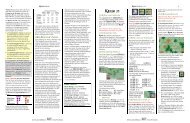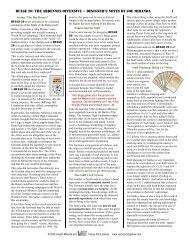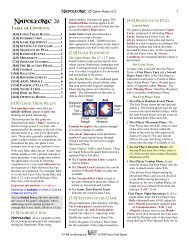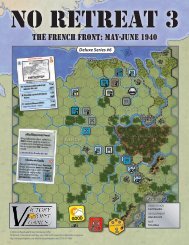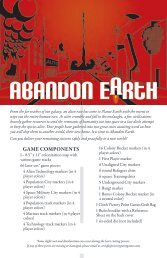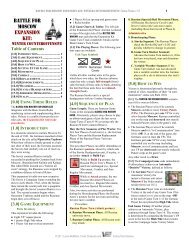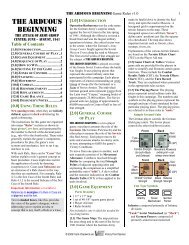Rules booklet - Victory Point Games
Rules booklet - Victory Point Games
Rules booklet - Victory Point Games
- No tags were found...
Create successful ePaper yourself
Turn your PDF publications into a flip-book with our unique Google optimized e-Paper software.
Napoleonic 20 Standard Game <strong>Rules</strong> v3.0 1Napoleonic 20Standard Game rulesTABLE OF CONTENTS[1.0] INTRODUCTION ............................ 1[2.0] GAME EQUIPMENT....................... 1[3.0] SETTING UP THE GAME ................ 2[4.0] SEQUENCE OF PLAY ..................... 2[5.0] RANDOM EVENTS ......................... 3[6.0] MOVEMENT .................................. 3[7.0] ZONES OF CONTROL .................... 4[8.0] THE REACTION PHASE ................ 5[9.0] COMBAT ....................................... 6[10.0] RALLYING ................................. 12[11.0] REINFORCEMENTS .................... 13[12.0] ARMY MORALE ........................ 13[13.0] PASSING (“LULLS”) .................. 14[14.0] NIGHT TURNS ........................... 15[15.0] HOW TO WIN ............................ 15[16.0] OPTIONAL RULES ..................... 15EXCLUSIVE RULES ................... 22[0.0] USING THESE RULESNew gaming terms, when initially defined,appear in dark red lettering for quickreferencing.The instructions for this game are organizedinto major “<strong>Rules</strong>” sections as shown in largegreen CAPS font, and represented by thenumber to the left of the decimal point (e.g.,Rule 4.0 is the fourth Rule). These <strong>Rules</strong>generally explain the game’s subject matter,its components, the procedures for play, thegame’s core systems, how to set it up, andhow to win.With each Rule, there can be “Cases” thatfurther explain a Rule’s general concept orbasic procedure. Cases might also restrict theapplication of a Rule by denoting exceptionsto it. Cases (and Subcases) are an extensionof a Rule shown in the way that they arenumbered. For example, Rule 4.1 is the firstCase of the fourth Rule; and Rule 4.1.2 is thesecond Subcase of the first Case of the fourthRule.Important information is in red text.References to examples of a Rule or Case are inblue text and this font.Text in shaded boxes, like this, provides thevoice of the game’s designer, who isaddressing you to explain an idea or conceptthat is not, itself, a Rule or a Case.[1.0] INTRODUCTIONNapoleonic 20 is a wargame system forrecreating operational level campaigns duringthe Napoleonic Wars using about 20 pieces(often less) per side per game. This Standard<strong>Rules</strong> section applies to all games in theseries, each of which also has its ownExclusive <strong>Rules</strong> section at the end.Game Scale: Each unit represents a divisionto a corps of troops (roughly 8,000 to 20,000men and their equipment). Each space on themap is approximately one-half to one mileacross.[2.0] GAME EQUIPMENTThe Game Map: The game board featuresa map portraying the area where that battleor campaign took place. Superimposedover it is a hexagonal grid that regularizesthe pieces’ movement and positioning.The Playing Pieces: The cardboard gamepieces* represent the actual military unitsthat participated in the campaign. Theseplaying pieces are called ‘units’ and theinformation on each is read as shown:Designation(2nd Corps)Type(Infantry)FrontCombatStrengthMovementAllowanceBackHiddenUnit(French)Combat Strength is the value of that unitwhen engaging in combat.Movement Allowance is the speed andendurance of that unit; basically, it is themaximum number of Open terrain hexesthat unit can move through during a singleMovement Phase.© 1999 Joe Miranda and © 2013 <strong>Victory</strong> <strong>Point</strong> <strong>Games</strong>



